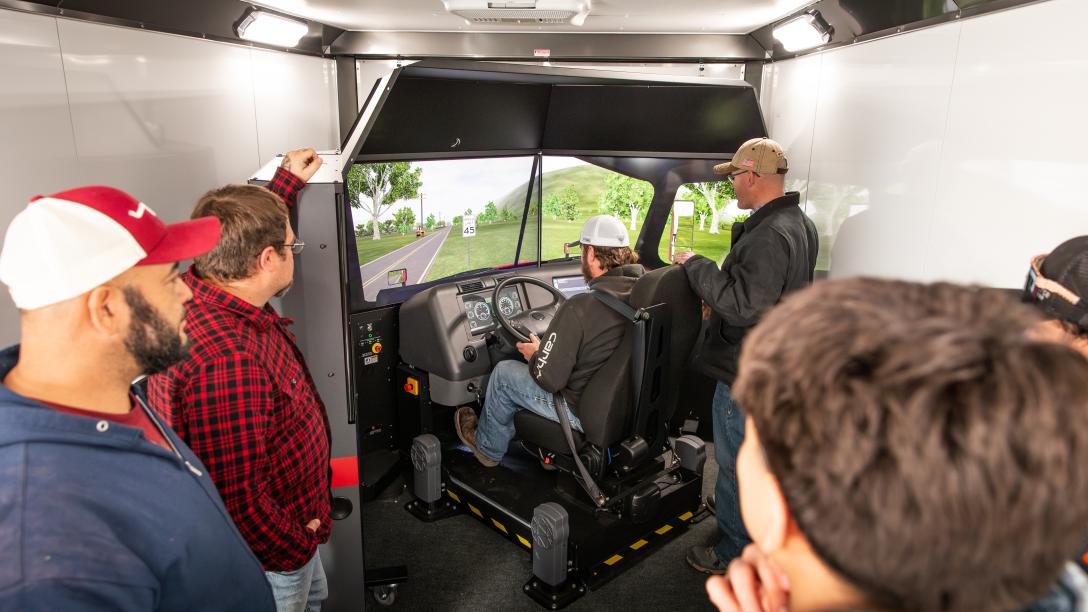Last fall, Aims Community College purchased a Commercial Driver’s License (CDL) driving simulator to help train and recruit the next generation of truck drivers.
Category
- Press Release
Audience
- Alumni
- Faculty
- General Public
- Staff
- Students
Related Links
Aims Community College Embraces CDL Simulator Technology for Enhanced Commercial Driver Training
Aims Community College Embraces CDL Simulator Technology for Enhanced Commercial Driver Training

Innovative tools like commercial driving simulators are revamping training techniques and boosting recruitment for this in-demand career.
Aims’ CDL program invested $100K in an L3Harris Driving Training system to provide hands-on experience for drivers before they get behind the wheel of a semi-truck. This technology has brought the college enhanced training opportunities for learners.
Advances in Training
CDL Program Director Martin Rubalcaba has seen excellent results in the first six months of using the simulator and said it has reduced training time. “They get the concepts a lot faster. We see that it usually cuts about two days of training," he said. “That means they get more behind-the-wheel time.”
One of the key concepts that a new CDL driver must master is shifting the truck since it is very different from driving a car with a stick shift. The simulator screen can display a graph that shows a student driver the appropriate time to shift into the next gear. “The big thing about shifting is getting those mechanics down to get the truck moving,” Rubalcaba said.
The simulator can give students a window into what driving a semi-trailer in urban or rural settings is like. Training is also enhanced, as instructors can introduce extreme weather, defensive driving or hazard-laden scenarios without risks to people or equipment. “I don't want to be in a physical truck with a new CDL driver when it’s snowy or icy,” Rubalcaba explained. “I can give them a simulated scenario to give them some experience driving a truck on ice or snow.”
Once students get comfortable in the simulator, they can practice driving semi-trucks on private roads on two acres of the Fort Lupton Campus. This controlled environment is an essential place to start without the pressures of traffic. Trainers report positive results when students are more comfortable behind the wheel. “It's much less stressful on the student,” Rubalcaba said. Mistakes such as missing gears and taking turns too short are reduced after learners get their start on the simulator.
This technology integrated into the program has helped students prepare for their CDL exams, encouraged safe driving practices, and kicked off careers in commercial driving.
Expanded Recruitment Opportunities
The Aims CDL simulator is housed in a mobile trailer and can be taken to special events and career fairs to foster interest in commercial driving careers. This hands-on experience has received an excellent response from the community.
Rubalcaba observed that “the younger generation loves it. It's a big video game for them and they enjoy it.” He has also seen that this enthusiasm extends to all ages: “The older crowd is also fascinated by it and has a great time” driving the simulator.
The simulator can also give those not inclined toward a trucking career a little more respect and understanding for sharing the road with big rigs and the industry overall. “We like to have people jump in there,” Rubalcaba said. “Show them what it's like to drive a large truck.”
Commercial Drivers License Training Program
The Aims CDL program is in high demand due to its location in Weld County and affordability, as it is one of the lowest-cost options in Colorado. Depending on the student, the course takes about three to four weeks to complete. A new cohort usually begins at the beginning of each month and finishes by the end of the month.
The CDL program keeps expanding its reach to attract people not traditionally well-represented in the trucking industry. Approximately 90 percent of the students in the program are male, but Rubalcaba sees opportunities for females growing. “Women get jobs in the industry because they tend to be safer and more cognizant drivers,” he said.
Another audience that the Aims program wants to attract is underemployed people in traditionally underserved communities. Enrollment is growing in Hispanic and African American communities. Beginning this summer, a new program will offer a CDL cohort for non-native English speakers to provide English Language Learning classes with CDL training. In addition, Aims is working on obtaining grant monies to bring funding to support a refugee training program.
Twenty-five percent of Aims CDL program participants have their tuition paid by their employers, such as local governments, large corporations, construction companies and more. The remaining 75 percent of students pay the tuition out of pocket since this short-term program is not eligible for traditional forms of student aid. Some assistance is available through Workforce Development programs in each county.
Aims' CDL program offers opportunities to obtain a commercial learner permit, Class A and B licenses, and Hazardous Materials Endorsement. More information and an interest form are available at aims.co/cdl.

